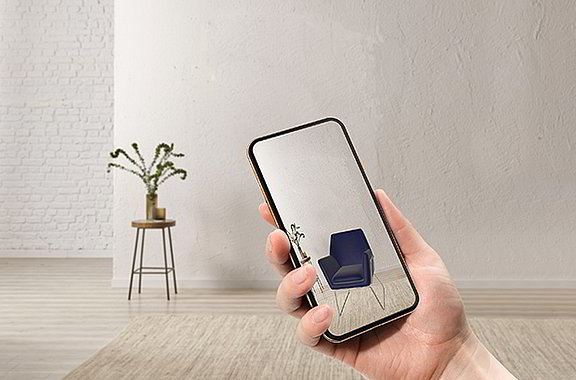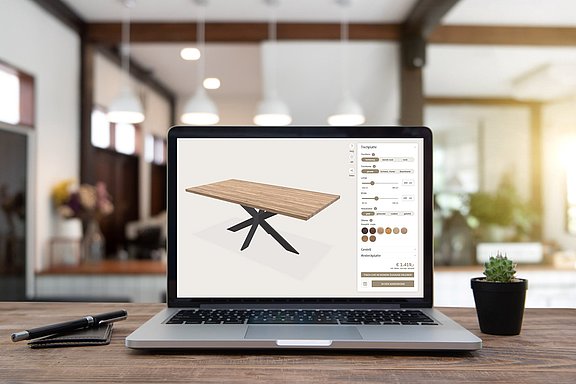Configurator software: definition, advantages, types and use cases
A product configurator transforms customers from passive consumers into co-creators. What possibilities does modern configurator software offer, and how do customers and sales benefit in concrete terms? We explain what modern solutions can do and what advantages they offer for a modern customer experience.
What is configurator software?
With configurator software, users can adapt a product according to various criteria and rules or assemble it themselves from individual components. Product configurators are basically used in all industries in which products are supplied individually or customized. The scope of possible configurations ranges accordingly from simple adjustments such as color to the exchange of standardized parts to the complete design of a product.
In B2B environments, for example, they are used by engineering companies and manufacturers to create customized solutions. In the B2C sector, configurators can be found on websites of companies that allow their customers to design personalized products.
A product configurator is either aimed directly at end customers and made available via a website, or it is designed for internal use in sales.
Via interfaces to ERP or CRM, configurator software can access relevant data so that, for example, unavailable components can be removed from the configuration in real time. At the same time, the product configurator in turn generates valuable data on trends and preferences of the various target groups. By identifying correlations and regularities in the selection of customers, companies can thus secure conclusions for product development, production planning, purchasing, and marketing and sales.
Product configurator types: 2D, 3D and AR configurator
Configurator software allows the creation of personalized shopping experiences in the digital world. When choosing the right software solution, companies can choose from the following types of configurator software, which differ in how the configured products are displayed:
- 2D configurators: These product configurators show a two-dimensional image of the configured product. In the simplest variants, the image is generated at the end of the configuration based on the inputs. Modern configurator software often generates these images in real time. 2D configurators are thus primarily suitable for customizable products such as posters or objects with engravings, where the composition or correct positioning is important.
- 3D product configurators: Modern configurator software displays products with a three-dimensional model. Customers can thus view products from all sides and get a feel for various details. This makes 3D configurators particularly suitable for complex products such as cars, kitchens, furniture or entire buildings. You don't have 3D models? Combeenation will be happy to create the data for you at a fixed price.
- AR Configurator Software: Augmented Reality refers to the integration of virtual objects into the real environment. In this way, products can be viewed directly where they will be used, and customers get a better feel for the effect of furniture, clothing, or color concepts in their homes.

Configurator software: advantages for the customer experience
For the creation of a modern customer experience, configurator software offers these advantages, among others:
- Personalization: End customers can customize products according to their own preferences and thus receive a product that more closely matches their needs.
- Marketing of complex products: Configuring complex products is non-trivial for non-specialists. A guided selling process allows customers to specify their requirements via a questionnaire, which are then translated for the configurator. This reduces the likelihood of frustration and abandoned purchases.
- Promoting the purchase decision: The visual representation of the configured products helps customers make informed purchasing decisions. They see the products from all sides and are more likely to build an emotional connection to the product by participating in the design process.
- Communicating product information: A configurator allows customers to explore a product portfolio in a fun way, without having to scroll through catalogs or web store pages. In this way, companies can create a clear unique selling point compared to the major platforms.
Product configurator as an internal sales tool: CPQ software
The term "configurator software" covers not only product configurators for the end customer, but also internal tools for sales staff. It is better known as CPQ software. CPQ stands for: "Configure, Price, Quote." It enables sales to assemble complex products and solutions without errors, calculate prices automatically and create quotation documents. CPQ configurator software thus offers these four advantages, among others:
- Reduced training efforts for new sales staff: Thanks to product configurators, new sales staff can work faster and more efficiently because the configurators already take complex product requirements into account, which shortens extensive training sessions.
- Minimization of errors during quotation creation: Product configurators minimize errors during quotation creation because they ensure the accuracy and consistency of the quotations created, thus eliminating potential sources of error.
- Acceleration of the quotation process: Product configurators significantly speed up the quotation process by automatically collecting relevant information and providing a consistent quotation format.
- Optimizing quotes for a higher success rate: By using product configurators, companies can optimize their quotes by tailoring them to the exact needs and preferences of customers, which increases the quote success rate.

Challenges in modern sales - and how configurator software solves them
Digitalization and the growing dominance of the platform economy present companies with new challenges for the effective distribution of their products. Against this background, product configurators are a useful tool for overcoming the following hurdles and positioning oneself successfully in the market of the future:
Challenge: Positioning in a digital environment
With digitalization, customers have access to products and information about them at all times. At the same time, digital platforms and the ubiquity of smartphones and apps are making the process of searching and buying ever more straightforward. In B2C business, therefore, neither price nor availability are increasingly sufficient unique selling points to stand out from the global digital competition. For customers, soft factors are becoming increasingly important when making purchasing decisions: How good is the service I receive from this provider? How uncomplicated is the product selection? They expect personalized offers and recommendations and at the same time want a consistent experience across different sales channels.
Product configurators enable customers to customize their products themselves and allow sales to streamline the quoting process. This allows companies to create a shopping experience that is significantly different from the average experience on a digital platform.
Challenge: Consistent omni-channel sales experience
Omni-channel approaches are the future. Companies need to be present across different channels and offer a consistent customer experience, but the conditions in the classic retail store and the online store are very different. In the store, customers can view their products from all sides, try them out, and directly compare different variants.
By implementing a web configurator, customers can also view products from different angles in a virtual environment, adjust them and compare variants with each other, similar to stationary retail. In this way, they can also explore products intensively in the digital space and adapt them to their own ideas.
This creates a seamless bridge between the different channels and enables customers to take advantage of both worlds while enjoying a consistent shopping experience.
Challenge: More complex products and services
The batch size in the manufacturing industry is decreasing - in other words, the number of products required for economic production. As a result, flexibility with regard to the individualization of products has grown significantly.
Product configurators make this flexibility accessible to customers and, on the other hand, facilitate the preparation of quotations for complex products with many customization options for individual parts that may still be interdependent. The visual representation of the configured products helps customers make informed purchasing decisions. They get a better impression of the product and are more likely to build an emotional and mental connection to it. This increases the likelihood of a deal.
Conclusion: The right configurator solution for your company
From personalized jewelry to customized automobiles, product configurators have revolutionized the way we shop. Configurator software makes virtual shopping more personal, transparent and convenient for customers. Modern solutions such as those from Combeenation not only offer a structured sales process, but also bring your products to life in the virtual world.
Want to know how Combeenation can help you create the shopping experience of the future? Then make an appointment for a demo!